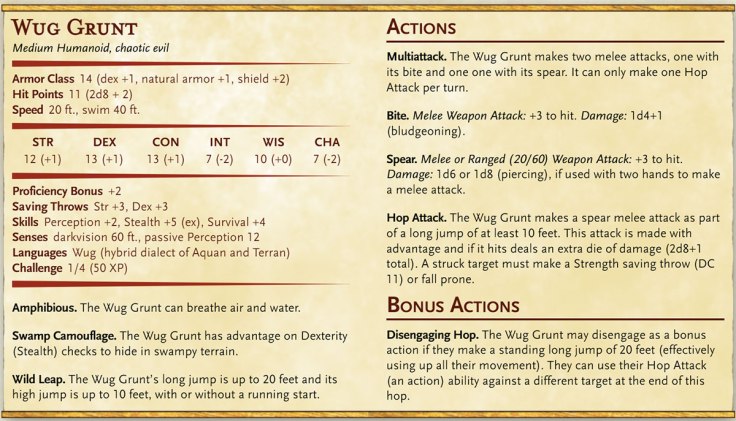If you know me in a D&D context, you probably know I love bullywugs.

I don’t know exactly when or why my love of the frog-headed humanoids first began, but I do know that basically every D&D campaign I have run since I first read about them in the AD&D Fiend Folio has featured them to some degree. Often they were just random encounters or a wandering monster, but at least once the PCs had to stop a froggy horde before bully-pollywugs joined the war and turned the tide against humanity.
I used them and referred to them so frequently that at my table it was not uncommon to simply shorten their name to “wugs,” and I’d often have NPCs refer to them as such. Because of this, I have decided to call the version described here “wugs” as well (since technically “bullywugs” are not part of the 5E SRD or in the Creative Commons).
Speaking of re-named bullywugs, the version that appears in MCDM’s Flee, Mortals!—called “Angulotls”—are pretty good and I recommend checking them out. While in general I find this version of frog-men to suffer from the same issue that most (if not all) the monsters in Flee, Mortals! have, I do think they are worth making use of or snagging powers from. What is the issue with MCDM’s monster book, you ask? Well, since it is unlikely I will do a full review of the book, I will say that I find its monsters too complex—even for me. Too many varieties of each creature only adds to that complexity, and I think it is too much to keep track of as a DM, especially if you are running an encounter with mixed monster types. I prefer monsters of the same general type to all have a similar set of powers with variations that build on the same general mechanic (they are just better at it) and maybe one additional power. While the monsters in Flee, Mortals! do this to some degree (by established “defining qualities” that all members of a species share), the added powers often create a level of complexity I find daunting.
Maybe it is just that it is easier for me to keep a bunch of different powers in mind if I come up with them myself and MCDM’s aren’t as hard to run as I imagine. I’d have to actually use some as written to know for sure, but for now, I did steal the “toxiferous” ability all of MCDM’s Angulotls have as a defining quality for the Night Croaker, along with the book’s “Dazed” condition.
According to Flee, Mortals!, a Dazed creature can only do one of the following things on their turn: move, use an action, or use a bonus action. However, I would add that they also cannot take reactions while dazed.
Oh and I think “Angulotl” is a mouthful and not a great name.
Nevertheless, however, I still recommend buying Flee, Mortals! if you can. It is pricey, but a great book with a lot of good ideas to mix and match in your own games and homebrew settings.
Primary among wug features is their hop attack. When 3E D&D came out, I was disappointed to see that the version of bullywug included in its Monster Manual did not have the essential special attack that helped define them in my eyes. I immediately put the hop attack back in. When I finally got my hands on the 5E books, I was similarly disappointed, which led to my coming up with the version(s) you’ll find here.
Most of all, I think 5E bullywugs have too many hit dice and hit points for CR 1/2 creatures. In fact, I think they should only be CR 1/4 creatures. They hit hard, but they are easy to take out on an individual basis, that is, if you can get them to stop hopping around long enough to land a blow.
You will only find three types of wugs below (as compared to six in Flee, Mortals!) and one of them—the Wug Gang Leader—is basically just a stronger wug with more hit dice. The Night Croaker is a kind of nocturnal wug bard with more of a toad-ish look. I would recommend tweaking the Angulotl Slink as a fourth kind of wug, though in terms of the niche I think wugs should fill (for low level encounters), I think Slinks have way too many hit dice. In my mind, a creature that is good at hiding and attacking from stealth should have fewer hit points, since actually getting to attack it is a challenge in itself. I’d give them 3d8 (between the Wug Grunt and the Gang Leader). That said, for some reason Angulotl’s have d6 hit dice despite being medium creatures, and I could find no explanation for this in the book (though not having read it cover-to-cover, I will admit I might have missed it).
Below you will find descriptions of the creature, a full stat block, and a link to the PDF version of the full description and 5E stat block. (For more info on the changes to stat blocks on HOW I RUN IT see the About STAT BLOCKS page.)
Click here for a PDF version of full description and stat block.





Leave a comment